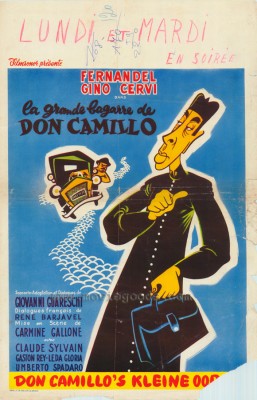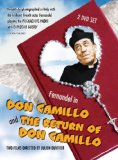| Reviews & Columns |
|
Reviews DVD TV on DVD Blu-ray 4K UHD International DVDs In Theaters Reviews by Studio Video Games Features Collector Series DVDs Easter Egg Database Interviews DVD Talk Radio Feature Articles Columns Anime Talk DVD Savant Horror DVDs The M.O.D. Squad Art House HD Talk Silent DVD
|
DVD Talk Forum |
|
|
| Resources |
|
DVD Price Search Customer Service #'s RCE Info Links |
|
Columns
|
|
|
Don Camillo and The Return of Don Camillo
In a welcome move, Koch Lorber Films is releasing officially restored versions of Don Camillo (1952) and The Return of Don Camillo (1953), two of Fernandel's most popular films, both directed by Julien Duvivier no less. The films are quite charming, stylistically reminiscent of Ealing's contemporaneous comedies from Great Britain.
Released in France as Le petit monde de Don Camillo ("The Little World of Don Camillo"), Don Camillo finds the conservative, combative priest (Fernandel) constantly at odds with the newly-elected mayor, ardent communist Giuseppe "Peppone" Bottazzi (Gino Cervi, probably best remembered for a long-running stint as French detective Maigret on Italian television). When the Reds are swept into the city council by an overwhelming majority, Don Camillo and the conservative community is aghast.
The priest and the mayor are soon at odds over everything. Each has his pet project: Don Camillo wants to build a city park while the mayor promises a citizen's center for his constituents. A sharp division arises within the community. The ancient schoolteacher Miss Christina (Sylvie) hates the communists but they're all also former pupils so she agrees to tutor them when they need help writing official documents. Young Gina (Vera Talchi), just back from boarding school, is shocked to discover that her secret childhood sweetheart, Mariolino (Franco Interlenghi), has become one of the most militant of the communist bunch, and of course their families hate one another.
But as much as the priest and the mayor publicly despise each other, privately they like and respect the other, and enjoy fighting and competing with one another for the city's attention and respect. That's really the foundation for this eventually heartwarming film, the notion that people from opposite ends of the political spectrum can still work, if not quite together, then at least for the common good and find common ground for friendship.
Though the film's humor is low-key and mildly eccentric in the Ealing manner, it's a positively radical social satire by early-1950s American standards. In Hollywood movies of the time, communists were never seen as anything other than murderous, slovenly pigs (usually played by Marvin Miller, Hans Conried, or Ivan Triesault types). As in most other European countries' films, the communists are more humorously depicted as pig-headed by-the-book types but well-meaning and dedicated. It's fascinating to watch, especially set in a country where the dichotomy would appear so extreme, traditional, conservative Catholics who become hardcore atheist communists.
Born Fernand Joseph Désiré Contandin, Fernandel might seem an unlikely candidate to play a small city Italian priest, but this was an Italian-French co-production where everything was shot silent and dubbed in post-production anyway, Italy's usual movie-making method at the time. Fernandel presumably is dubbed by an Italian actor though it hardly matters as his great charm lay in his enormously expressive, saucer-like eyes and facial features (most famously that toothy smile of his). Don Camillo seems to have been a major influence on director Giuseppe Tornatore; though Cinema Paradiso is set in Palermo and this takes place somewhere in Northern Italy, both films have the same small city community of mild eccentrics and, in Tornatore's film, the two leads - Philippe Noiret and Jacques Perrin - were likewise French. Few noticed or cared then, either.
In another taboo-breaking move (by American standards), throughout the film Don Camillo talks to Jesus, in the form of the Church's life-size crucifix - and Jesus answers back in a funny little offscreen voice (by Ruggero Ruggeri) that's almost indescribable and gently humorous in a way mainstream Hollywood would steer clear of even now. (Oh, God! sort of came close to this style of humor, however.)
The Return of Don Camillo (Il Ritorno di Don Camillo) picks up exactly where the first film ended, with the combative parish priest aboard a train, resigned to his fate and en route to the remote mountain community where he's been reassigned - a "village in the clouds" he calls it. Picturesque but extremely remote, Don Camillo is dismayed to find the dying village exclusively populated by old maids and the elderly, and even they won't attend his services on account of his reputation.
Meanwhile, back in his old community everyone seems to miss their old priest. Even ancient Dr. Spiletti (Édouard Delmont) on his deathbed refuses to die until Don Camillo returns to administer Last Rites. Don Camillo himself sneaks back to town to break into the church and retrieve his friend on the crucifix, now languishing in the sacristy. He asks Mayor "Peppone" (Gino Cervi) for help getting the cross back to his parish, and the two are delighted to see one another again, though each pretends not to.
Peppone is having troubles of his own. Conservative winemaker Cagnola (Thomy Bourdelle) refuses to turn over a small portion of his vineyards to the communists, who insist on building a dam there. The two come to blows and Peppone, believing he's killed the ornery farmer, comes to Don Camillo for help.
The Return of Don Camillo builds upon the first film's strengths, recognizing the charm of Don Camillo and Peppone's amusing, combative relationship, but it's also extremely episodic with no real narrative thread holding it together. The first film was released in early 1952, and just prior to when Italy's Po River (where the story is set) was flooded by heavy rains and, reportedly, a tidal wave. (Over 100 died, along with 30,000 head of cattle.) I suspect the film was built around this event and all the newsreel footage shot of it. Partly for this reason the film plays rather herky-jerky and unformed. The flood climax is visually spectacular in some respects (there are some impressive optical shots and miniatures) but it completely lacks the simple emotional payoff of the first picture.
Still, Fernando and Cervi are as delightful as ever and the film offers many funny and warm scenes. One such moment says it all: raising money to repair his damaged church tower, Don Camillo is surprised that Peppone would show up to Mass at all, much less come armed with a large kerchief crammed with lire. Peppone opens the kerchief, out pours the great wad of cash and the unraveled kerchief is revealed to be decorated with the hammer and sickle - which Peppone flutters like a flag in front of the priest, taunting his old friend and rival.
Video & Audio
Both Don Camillo and The Return of Don Camillo source the Italian-language versions (distributed by Cineriz) only, with optional (yellow) English subtitles. Interestingly, Giuseppe Amato is credited after Duvivier's name as realizzato on the first picture. The IMDb translates this as "delegate producer," but possibly Amato may have co-directed the Italian version or some such. It's too bad Koch Lorber didn't/couldn't include either the highly regarded English-dubbed version of the first film, which was narrated by Orson Welles, or the French versions that, presumably, would have offered Fernandal's own voice on the soundtrack. (Sources conflict over whether two versions were shot simultaneously - one in French, the other in Italian - or if one version was simply dubbed into multiple languages.)
The full frame transfers are very good; both have been restored by their Italian owners. The second film has lots of repeated frames to cover film damage, which pretty much seems limited to dissolves, fades, and other opticals. Most of both films look really good, sharp with deep blacks and good contrast. Both are mono with optional (yellow) subtitles. There are no Extra Features.
Parting Thoughts
I hope this two-disc set of Don Camillo/The Return of Don Camillo sells well for Koch Lorber. It deserves to, and it might facilitate the release of the three remaining sequels: Don Camillo's Last Round (Don Camillo e l'on. Peppone, 1955), Don Camillo, Monsignor (Don Camillo monsignore ma non troppo, 1961), and Don Camillo in Moscow (Il Compagno Don Camillo, 1965). These are charming little comedies that deserve a wider American audience. Highly Recommended.
Film historian Stuart Galbraith IV's latest book, The Toho Studios Story, is on sale now.
|
| Popular Reviews |
| Sponsored Links |
|
|
| Sponsored Links |
|
|
| Release List | Reviews | Shop | Newsletter | Forum | DVD Giveaways | Blu-Ray | Advertise |
|
Copyright 2024 DVDTalk.com All Rights Reserved. Legal Info, Privacy Policy, Terms of Use,
Manage Preferences,
Your Privacy Choices | |||||||















